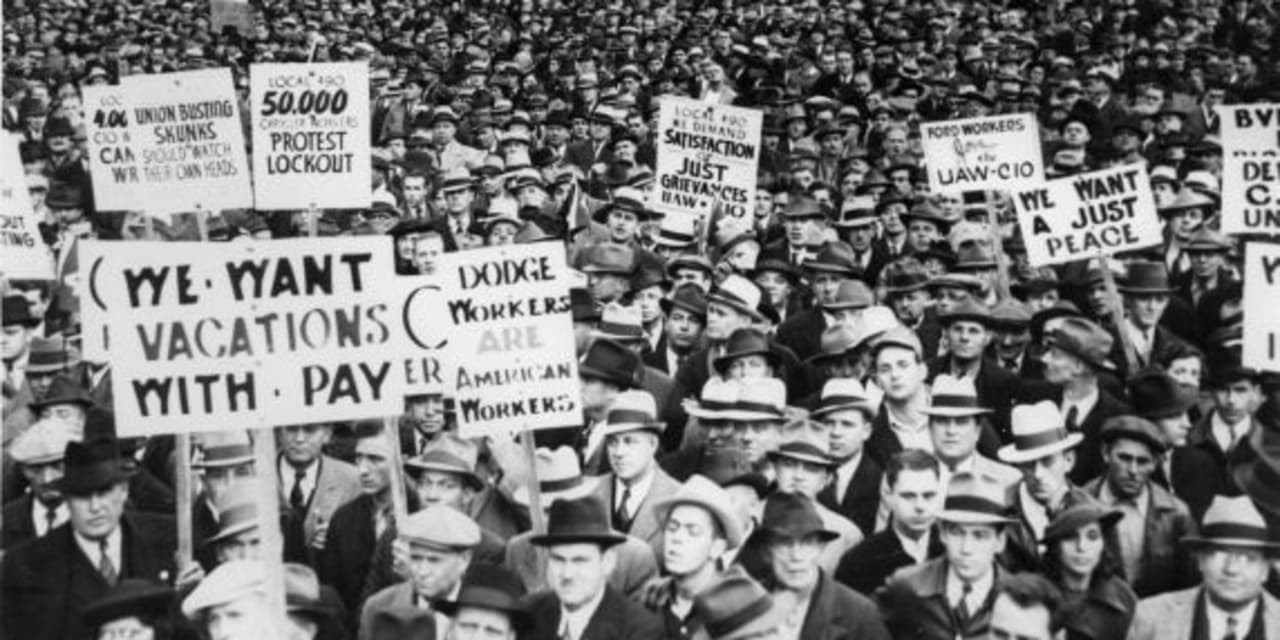About the author: Josh Wolfe is co-founder and managing partner of Lux Capital, a venture-capital firm.
We the people may always be seeking a more perfect union, but when it comes to America’s labor unions, imperfection has been the big story for decades now. Union membership crested at one in three American workers in the 1950s, only to dwindle to a record low in 2022 of 10.1%. It’s not hard to understand why: deindustrialization, globalization, and flexible supply chains have shredded company-worker relations. A series of high-profile corruption and embezzlement scandals at some top American unions certainly didn’t help.
It’s precisely at the bottom, though, that things start to look up. Investors shouldn’t overlook the immediate and second-order effects of the coming resurgence in union power.
While the proportion of unionized workers has dwindled, the absolute number grew by 273,000 last year. This paradoxical trend suggests that the American workforce is expanding, but the pace of unionization hasn’t kept up—yet. However, change is coming.
As the labor market shows signs of softening, with job creation falling, unemployment rates rising, and some experts seeing the window for major labor victories narrowing, there’s a noticeable shift in public consciousness towards unions. A staggering 67% of Americans now say they approve of unions, according to Gallup, a sentiment not seen since the mid-1960s. This dichotomy between dwindling membership and surging public support suggests a renaissance in collective bargaining power.
Already this year, we’ve witnessed one of the largest union contracts signed recently, with more than 340,000 UPS Teamsters preparing to strike before a last-minute deal was sealed in July. Similar blockbuster deals have been signed across the airline, health, and hospitality industries.
As unions expand their influence, especially into previously nonunionized bastions such as tech and retail, the balance of power between corporations and their employees is poised for recalibration. While this trend might seem like a clarion call for caution, it also offers opportunity for discerning investors. Thoughtful preparation and prudent portfolio balancing will allow investors to ride the waves of change rather than fight the currents. Most companies will have ample time to adapt business models before higher labor costs substantially impact the bottom line. And while union resurgence may modestly impact profits, it also creates new opportunities.
What are unions seeking? The same as always, but updated for a post-Covid world. Unions want better pay, more flexible and remote working arrangements, and much more expansive healthcare options. They also want greater job security coupled with protection from automation via artificial intelligence or robotics.
A key investment implication of labor’s revival lies in the power of negotiation. As unions regain influence, their bargaining clout will likely yield improved benefits for members. Take healthcare, for example. With unions poised to expand membership for the first time in years, we can expect more U.S. workers to gain expanded healthcare benefits thanks to collective bargaining. Companies specializing in fertility services, mental health, virtual primary care, advanced therapeutics and even weight-loss drugs such as Ozempic and Wegovy could see revenue boosts as newly unionized patients enter their addressable markets with corporate wallets covering the bill.
The momentum for more comprehensive healthcare seems poised to continue as younger, pro-union generations join the workforce and postpandemic disruptions prompt sympathies for frontline worker treatment. Take the United Auto Workers strike underway now against the Big Three Detroit automakers. One demand is more equality of healthcare coverage across all workers, ensuring that the newly hired apprentice and the veteran union steward both have the best care money can buy. Investors would be prudent to keep tabs on ongoing union contract negotiations and target firms well-positioned to capitalize on the influx of newly covered members.
This growth in benefits will be mirrored in industries as diverse as child-care providers, remote work enterprise software platforms, AI assistants that augment rather than replace workers, and education offerings. In addition, new contracts can have downstream effects for industrials and process engineering in order to match new work rules.
Astute watchers of the market should also scrutinize union-induced changes that ban certain corporate practices, most notably workplace monitoring. For example, the UPS Teamster contract stipulates that in-cabin camera recordings will no longer be allowed across the package carrier’s ubiquitous fleet of brown vans. Similar tracking platforms may face increased headwinds as worker’s clamor for additional at-work privacy protections.
If unions help rebuild America’s middle class, increased consumer spending could partially offset profit pressures. The future need not be a zero-sum game between labor and capital, and savvy investors might just find a new tailwind that others haven’t fully accounted for. A more perfect union could be good for workers, investors, and America as well.
Guest commentaries like this one are written by authors outside the Barron’s and MarketWatch newsroom. They reflect the perspective and opinions of the authors. Submit commentary proposals and other feedback to [email protected].
Read the full article here













